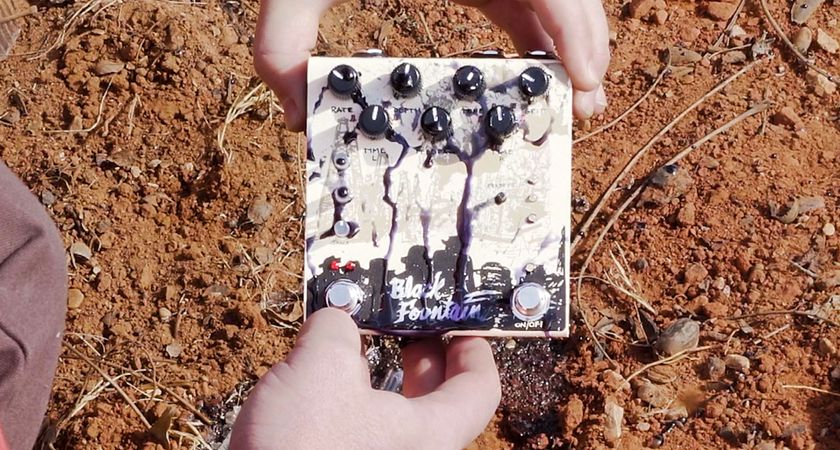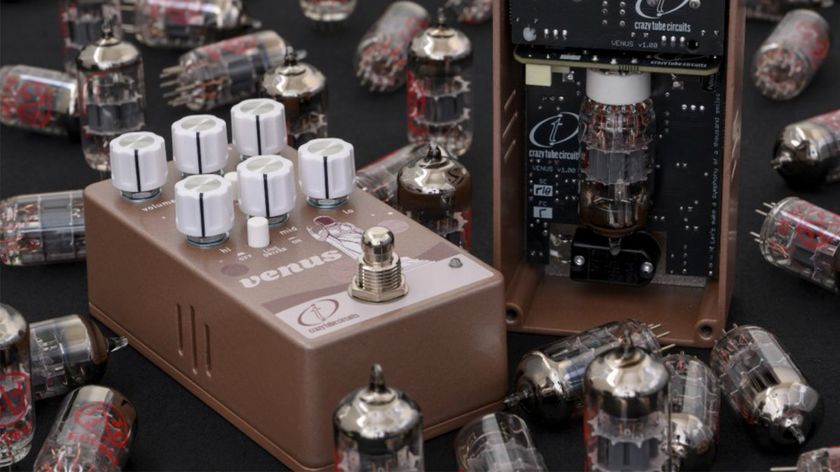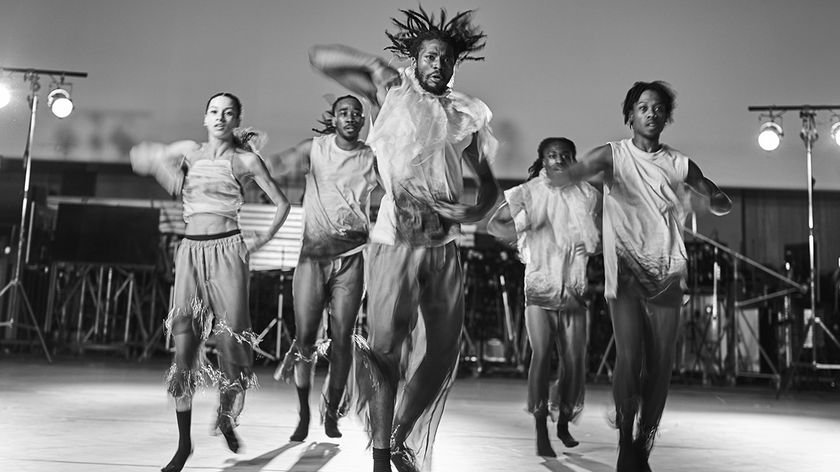Baroness's John Baizley: "Reversing that standard pedal signal flow is where the most interesting stuff happens"
The metal experimentalist on the band's new beginnings, guitar philosophy and pedalboard experiments

The band started by John Baizley in 2003 have certainly come a long way for a sludge-metal group from Savannah.
For starters, the music Baroness write and record today probably wouldn’t be considered sludge-metal - less abrasive than their early records, delving more into the atmospheric realms of indie shoegaze than Sabbathian heaviness.
The sole remaining founding member has survived the continual line-up changes, before and after the near-fatal bus crash in 2012 - which fortunately claimed no lives - and the post-traumatic depression that soon followed. The endurance has paid off: his band now share management with Metallica and have major labels co-ordinating releases under their own Abraxan Hymns banner.
Those aren’t things that any band, least of all myself, ever want to go through - but I’ve had incredible luck finding new members very quickly and easily
Speaking to MusicRadar ahead of this year’s fifth full-length Gold & Grey, where yet another chapter in the band’s evolution is marked by the introduction of new personnel, John Baizley is feeling driven and, ultimately, grateful.
“I have to say the past 15 years have been a series of very fortunate events in terms of line-up changes,” reasons the Baroness leader.
“Those aren’t things that any band, least of all myself, ever want to go through - but I’ve had incredible luck finding new members very quickly and easily, without working too hard.
“When Peter [Adams] decided to leave at the end of the Purple cycle, he wanted to do it in a way that didn’t have a wholly adverse effect on the band. He felt strongly about us continuing and all that hard work not to be in vain. We had time to deal with it…”
Get the MusicRadar Newsletter
Want all the hottest music and gear news, reviews, deals, features and more, direct to your inbox? Sign up here.
Here Baizley explains what happened next - the story behind new guitarist Gina Gleason, their choices in equipment for the latest opus and his very own guide to pedal-chaining…
When did you realise Gina was the person to help take the band forward?
I believe it took me about 10 seconds to realise I was playing with someone who was technically accomplished, with whom I also shared this definite chemistry and musical kinship
“At the time I don’t even think I was looking for a guitar player, but I working with my small DIY company [Philly Fuzz] that makes pedals and I noticed one of our first orders had come from my neighbourhood. It wasn’t like we were only selling locally - it was all going far and wide - so to see an address so close to my home was surprising.
“The engineer I work with said I really should check out her profile on Instagram, though he didn’t really give an explanation. So I did and she was incredible!
“Without any agenda whatsoever, I reached out saying we should jam. She came over to the basement studio in my old apartment and we set up some guitars. I believe it took me about 10 seconds to realise I was playing with someone who was technically accomplished, with whom I also shared this definite chemistry and musical kinship.
“It’s not every day I sit down with a stranger and find we have the same style and are able to play together immediately. When that happens - and given I needed a new guitar player - there was no question over what I should do. She’s so dedicated and ambitious, it’s been easy. Right from the start it felt like we’d improved already.”
So it was a relatively smooth transition in terms of line-up, then...
“It wouldn’t have been proper for me to say anything initially - Gina was living in Vegas at the time, which was far away from me. But it happened quickly - we jammed a few times, kept in touch and eventually asked her when I knew it was absolutely positive.
“I barely remember that time period in between Peter’s last show and Gina’s first. I don’t believe we ever took a step back. We just continued, which was a fantastic thing to experience, especially because having to switch rhythm sections for Purple took a lot of work. It’s a big deal replacing your bass player and drummer.”
You’ve been an avid user of effects pedals over the years. What’s being heard most on the new record?
“There’s one pedal I’ve used a lot on this album, as well as a handful of tracks from Purple. The builder’s name is Schumann and I believe he only makes two pedals, both of which are ridiculous and unique.
“They’re very pricey - actually, the PLL I used belonged to Dave Fridmann. It’s very bizarre with lots of weird knobs and dials with some kind of envelope follower, while also having this very rich fuzz tonal characteristic.”
There’s a fair amount of modulation and octaver, too…
Tthe Death By Audio stuff is out of this world and fantastic… we probably used one of their squeaky, noisy over-the-top things in every song
“We both used a [Micro] POG, the simple one with three knobs. I think it’s the only one you can combine with distortion or fuzz and have the sub-octave to come through articulate with enough punch. I have a really nice old Electro-Harmonix Polychorus. It’s almost impossible to control… which makes it a wonderful instrument to create sounds.
“I use the Strymon Mobius modulator for the heavier full-stereo flanger and phaser sounds. There’s also this company called Retro-Sonic that makes very faithful recreations of classic pedals, so I’ve got this compressor they make and this CE-2 chorus clone.
“In the studio, we’ll line up all the Moog pedals. I have to say the Death By Audio stuff is out of this world and fantastic… we probably used one of their squeaky, noisy over-the-top things in every song. We’ll also use Leslie cabinets for the rotary effects.
“Generally, though, we try not to use the same thing twice. I have a Strymon Timeline to do the big, wide and lush-sounding stereo effect. We also went deep into EarthQuaker Devices, as well as things like the EHX Memory Man, which is a favourite of mine.”
It sounds like it’s mainly single-coil guitars on this album…
“It’s almost all exclusively Fender this time. We used Jazzmasters, Teles and Strats. I think Gina used a Jazzmaster on every track.
Though I think the whole Gibson and Marshall combination was such a workable, recognisable feature in rock music, I felt like it was limiting me
“As for amps, we have our go-to Fender Princeton, plus I have this vintage Vibro Champ. I use a Twin when I need something with more headroom, but it’s all Fender and all single-coil. I might string up a guitar in Nashville tuning and put that in there, too.
“Though I think the whole Gibson and Marshall combination was such a workable, recognisable feature in rock music, I felt like it was limiting me. Our setup now leans more to the blues style. We might split in stereo and use stereo effects, but it all comes down to small combo amps between 10 and 30 watts.
“Switching over to single-coils, I found my level of expression has become more fluid and less familiar… and therefore more unique! It led to new ideas and sounds I hadn’t heard much in our relative genre before. Now it’s become a very important part of what we do.”
What else felt new about this recording experience?
“I have an interest in engineering and production as well, so we took a small mobile section of my outboard hardware which has this Radial EXTC, which essentially allows you to use effects pedals in a robust way on mic level signals. It converts mic to line or line to mic, blending in a pedalboard. I can run vocals and mix in delay or a fuzz on my vocal signal without compromising fidelity.
“We’d pick through all sorts of guitar effects for vocals: on the song I Do Anything which has few guitars within it, we did this orchestration using standard mics as well as some of the nice copperphone ones, mimicking string or horn sections or brass. Plus double bass and viola, clarinets and oboes… creating symphonics only through the use of voice. We’d try to emulate those sounds with our mouths and lips, plus drench them in fuzz, reverb and delay.”

There’s definitely a discernible openness to the tools around the guitar playing, using capos or slides in ways reminiscent to what Radiohead have done in the past…
“We’ll play with capos even on our louder songs, or we might use slides and EBows simultaneously or kick in the DigiTech Whammy all over the place. The Whammy came to the forefront on this record, but in a subtle way. Gina knows how to find a sweet spot on the pedal where it’s the dry signal plus something off by some strange interval. It’s further than chorus but not quite a pleasant harmonic experience!
“It’s all about what supports the idea and texture of the song, but also trying to reimagine what heavy music is by avoiding standard tropes, circumventing the status quo or standard mechanisms. That can make it difficult to keep efficiency - because this is a new style, born out of the idea of evolving and pushing our sound forward. Using equipment that’s less typical makes us more adventurous and creative when writing and recording songs.”
As for fuzz and gain, did you use any of your own pedals?
If we ever felt the tones were too rich or subtle or acceptable, we’d just go straight into the board for something completely insane
“I’m naturally familiar with them! I don’t have to go searching through Big Muffs to find a good one of those or the thousand other legendary pedals out there… many of which I own. As I had the ones I designed and made with my partners, they made a lot of noise on the new record.
“My foundation distorted tone comes from a Crowther Hot Cake, which I bought from Paul Crowther himself while I was out in New Zealand. It’s the Double Hot Cake, so has it has two different drives which I can stack together. Sometimes we’d do the opposite - if you listen to the song Borderlines, there’s this gigantic riff that kicks in after the chorus… it’s the loudest guitar sound on the record and that’s me and Gina plugged directly into a preamp going into the board!”
There is definitely that sense of going into the red at points…
“Yeah, there’s a lot of direct guitar going into the board driving preamps as far as they’ll go. Dave has everything; all of his gear is modded to make it even more intense. If we ever felt the tones were too rich or subtle or acceptable, we’d just go straight into the board for something completely insane.
“It’s impossible to say how much we used; there were hundreds of different combinations. We kept swapping mics and preamps to make sure it was changing constantly as we recorded.
“With that comes the risk of some stinky tones, but changing was important. A lot of tracking was done in my home studio, just carving out different sounds. I used a lot of clean sounds. Over the years, I’ve found dialling back on the dirt allows for a more dynamic performance but also a greater level of precision sculpting the tones we use.”
As it’s an area of expertise, what’s your general guide to pedal-chaining?
“If you are trying to get into the world of effects, there is a standard flow your signal should go through. That’s how you can get the more regular and anticipatable results.
“Generally, your compressor goes first, then a low drive, then a deeper drive, then an octave followed by fuzz into the modulations and delays. That’s how I think live anyway, because I need some control… occasionally! I have a very complicated [TheGigRig] G2 switching system that allows me to do a ton of stuff.

“But I think reversing that standard signal flow is where the most interesting stuff happens. Sometimes I get tired of hearing the same things going in that predictable direction… it sounds good but I’ve also heard someone else doing it.
“When I need something that sounds unique which I might not have control over, I might put my phaser and delay or reverb right at the beginning. The reverb will have a nice decay so the phaser will apply itself to the tail of the reverb and I will then send that to fuzz, which will mangle and distort it in a way that continues to unfold and blossom…”
And have a life of its own?
“Exactly: you can take your hands off the guitar and the effects will respond without you having any control. It’s that reversal of the common sense where things can get really wild. Things will self-oscillate and expand, then I’ll end the chain in a more relatable way. Sometimes I just don’t know what’s happening or coming out the speakers… but it’s pleasant!
“The studio is a creative soundscape playground. There are standard ways to use effects and then there are the occasions we might use them in a counterintuitive or backwards way, manipulating them to mimic something else or create a brand new sound.
Defying the conventional wisdom of sound-making, engineering or mixing has led me to much greater discoveries beyond that particular sound
“It’s all about experimenting. You understand the rules so that you can break them in a convincing way. Defying the conventional wisdom of sound-making, engineering or mixing has led me to much greater discoveries beyond that particular sound. It can decontextualise my guitar sound enough for me to start writing something new and fresh.
“When you don’t have control, you are out of your comfort zone and you have to create in a different way. See what the results are and when it’s a good one, catalogue it in your head or write it down.”
A lot of people who own effects pedals might not be aware how far a few simple units can take them…
“That’s the fun thing about effects. We made distortion, delay, reverb and chorus for their specific functions - to fill out the sound or create atmosphere. When you throw everything but the kitchen sink at it, you are no longer trying to generate an atmosphere you understand. You are trying to create something new. Only your ears can tell you what’s happening and what use it can be. Sometimes you can feel like you are pioneering something as yet unheard.
“That’s what I tell everyone: go and create one sound with that idea in mind, something which nobody has ever heard before. Isn’t that where we are at with music right now? We’ve all heard Hendrix, Jimmy Page and Adrian Belew, now it’s obligatory for us as sonic pioneers to create new reactions. Imagine how sounds can reinforce your music - fitting in creatively, conceptually or philosophically!”
Amit has been writing for titles like Total Guitar, MusicRadar and Guitar World for over a decade and counts Richie Kotzen, Guthrie Govan and Jeff Beck among his primary influences. He's interviewed everyone from Ozzy Osbourne and Lemmy to Slash and Jimmy Page, and once even traded solos with a member of Slayer on a track released internationally. As a session guitarist, he's played alongside members of Judas Priest and Uriah Heep in London ensemble Metalworks, as well as handling lead guitars for legends like Glen Matlock (Sex Pistols, The Faces) and Stu Hamm (Steve Vai, Joe Satriani, G3).

“Perfect for chorusing, doubling, slapback, and long rhythmic delays alike”: Old Blood Noise Endeavors’ Black Fountain Stereo is an oil can delay emulation pedal packed with modern features

“A vast tonal palette from gnarly, aggressive distortion to smooth, creamy overdrive. ”: Crazy Tube Circuits cooks up a crazy tube circuit for real – meet Venus, an overdrive pedal with an “oddball” ECC832 inside











